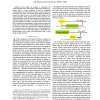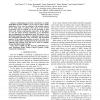ICRA
2009
IEEE
13 years 9 months ago
2009
IEEE
This paper presents a new algorithm for object handling tasks based on active tactile and slippage sensations using a humanoid robot multi-fingered arm for an object that exists at...
ICRA
2009
IEEE
13 years 9 months ago
2009
IEEE
Although RANSAC is the most widely used robust estimator in computer vision, it has certain limitations making it ineffective in some situations, such as the motion estimation prob...
ICRA
2009
IEEE
13 years 9 months ago
2009
IEEE
For haptic devices, compensation of the robot's gravity is a frequent strategy with the aim to reduce interaction forces between robot and human in zero-impedance control. How...
ICRA
2009
IEEE
13 years 9 months ago
2009
IEEE
Abstract-- A main difficulty that arises in the context of probabilistic localization is the design of an appropriate observation model, i.e., determining the likelihood of a senso...
ICRA
2009
IEEE
13 years 9 months ago
2009
IEEE
In this paper, an insect-inspired motion detector (Reichardt-model) is applied to visual servo control to ensure the stability of the system with high gain and time delay in its fe...
ICRA
2009
IEEE
13 years 9 months ago
2009
IEEE
In this paper we propose a framework for synchronization based control (SBC) using neural oscillators for motion assist. A neural oscillator is used to accomplish synchronization a...
ICRA
2009
IEEE
13 years 9 months ago
2009
IEEE
A method of regrasp planning for humanoid robot manipulation is proposed. We adopt pivoting manipulation for the humanoid robot to move a bulky object without lifting in a stable a...
ICRA
2009
IEEE
13 years 9 months ago
2009
IEEE
Maintaining the network connectivity in mobile Multi-Robot Systems (MRSs) is a key issue in many robotic applications. In our view, the solution to this problem consists of two mai...
ICRA
2009
IEEE
13 years 9 months ago
2009
IEEE
In this paper, we propose a human daily activity recognition method by fusing the data from two wearable inertial sensors attached on one foot and the waist of the human subject, r...
ICRA
2009
IEEE
13 years 9 months ago
2009
IEEE
Abstract-- Despite the frequent use of the Lawrence ar


